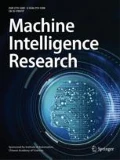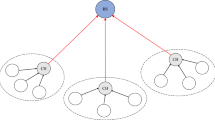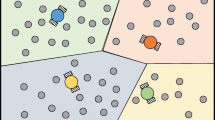Abstract
Exploiting mobile elements (MEs) to accomplish data collection in wireless sensor networks (WSNs) can improve the energy efficiency of sensor nodes, and prolong network lifetime. However, it will lead to large data collection latency for the network, which is unacceptable for data-critical applications. In this paper, we address this problem by minimizing the traveling length of MEs. Our methods mainly consist of two steps: we first construct a virtual grid network and select the minimal stop point set (SPS) from it; then, we make optimal scheduling for the MEs based on the SPS in order to minimize their traveling length. Different implementations of genetic algorithm (GA) are used to solve the problem. Our methods are evaluated by extensive simulations. The results show that these methods can greatly reduce the traveling length of MEs, and decrease the data collection latency.
Similar content being viewed by others
References
A. Bharathidasan, V. Ponduru. Sensor Networks: An Overview, Technical Report, University of California, Davis, USA, 2002.
J. Heo, J. Hong, Y. Cho. EARQ: Energy aware routing for real-time and reliable communication in wireless industrial sensor networks. IEEE Transactions on Industrial Informatics, vol. 5, no. 1, pp. 3–11, 2009.
Y. Wu, X. Li, Y. Liu, W. Lou. Energy-efficient wake-up scheduling for data collection and aggregation. IEEE Transactions on Parallel and Distributed Systems, vol. 21, no. 2, pp. 275–287, 2010.
Y. Xiao, H. Chen, K. Wu, B. Sun, Y. Zhang, X. Sun, C. Liu. Coverage and detection of a randomized scheduling algorithm in wireless sensor networks. IEEE Transactions on Computers, vol. 59, no. 4, pp. 507–521, 2010.
G. Xing, T. Wang, Z. Xie, W. Jia. Rendezvous planning in mobility-assisted wireless sensor networks. In Proceedings of the 28th IEEE International Real-time Systems Symposium, IEEE, pp. 311–320, 2007.
G. Xing, T. Wang, W. Jia, M. Li. Rendezvous design algorithms for wireless sensor networks with a mobile base station. In Proceedings of the 9th ACM International Symposium on Mobile Ad Hoc Networking and Computing, ACM, pp. 231–240, 2008.
M. Marta, M. Cardei. Using sink mobility to increase wireless sensor network lifetime. In Proceedings of International Symposium on a World of Wireless, Mobile and Multimedia Networks, IEEE, pp. 1–10, 2008.
M. Martaa, M. Cardei. Improved sensor network lifetime with multiple mobile sinks. Pervasive and Mobile Computing, vol. 5, no. 5, pp. 542–555, 2009.
R. Shah, S. Roy, S. Jain, W. Brunette. Data MULEs: Modeling a three-tier architecture for sparse sensor networks. In Proceedings of IEEE Workshop on Sensor Network Protocols and Applications, IEEE, pp. 30–41, 2003.
R. Saravanan, S. Ramabalan, C. Balamurugan, A. Subash. Evolutionary trajectory planning for an industrial robot. International Journal of Automation and Computing, vol.7, no. 2, pp. 190–198, 2010.
T. J. Li, G. Q. Chen, G. F. Shao. Action control of soccer robots based on simulated human intelligence. International Journal of Automation and Computing, vol. 7, no. 1, pp. 55–63, 2010.
Neptune Canada, [Online], Available: http://www.neptunecanada.ca/, 2010.
L. Yang. Optimising locations of sink nodes in wireless sensor networks using genetic algorithms. Measurement + Control, vol. 39, no. 7, pp. 214–217, 2006.
J. H. Holland. Adaptation in Natural and Artificial System, Ann Arbor, USA: The University of Michigan Press, 1975.
M. M. B. Tariq, M. Ammar, E. Zegura. Message ferry route design for sparse ad hoc networks with mobile nodes. In Proceedings of the 7th ACM International Symposium on Mobile Ad Hoc Networking and Computing, ACM, pp. 37–48, 2006.
D. K. Goldenberg, J. Lin, A. S. Morse, B. E. Rosen, Y. R. Yang. Towards mobility as a network control primitive. In Proceedings of the 5th ACM International Symposium on Mobile Ad Hoc Networking and Computing, ACM, pp. 163–174, 2004.
J. Butler. Robotics and Microelectronics: Mobile Robots as Gateways into Wireless Sensor Networks, Technology@Intel Magazine, 2003.
A. LaMarca, W. Brunette, D. Koizumi, M. Lease, S. B. Sigurdsson, K. Sikorski, D. Fox, G. Borriello. Making sensor networks practical with robots. Lecture Notes in Computer Science, Springer, vol. 2414, pp. 615–622, 2002.
E. Ekici, Y. Gu, D. Bozdag. Mobility-based communication in wireless sensor networks. IEEE Communications Magazine, vol. 44, no. 6, pp. 56–62, 2006.
S. R. Gandham, M. Dawande, R. Prakash, S. Venkatesan. Energy efficient schemes for wireless sensor networks with multiple mobile base stations. In Proceedings of Global Telecommunications Conference, IEEE, pp. 377–381, 2003.
J. Luo, J. Hubaux. Joint mobility and routing for lifetime elongation in wireless sensor networks. In Proceedings of the 24th Annual Joint Conference of the IEEE Computer and Communications Societies, IEEE, pp. 1735–1746, 2005.
Z. M. Wang, S. Basagni, E. Melachrinoudis, C. Petrioli. Exploiting sink mobility for maximizing sensor networks lifetime. In Proceedings of the 38th Annual Hawaii International Conference on System Sciences, IEEE, Big Island, Hawaii, USA, vol. 9, pp. 287, 2005.
A. Chakrabarti, A. Sabharwal, B. Aazhang. Using predictable observer mobility for power efficient design of sensor networks. In Proceedings of the 2nd International Conference on Information Processing in Sensor Networks, Springer, pp. 129–145, 2003.
Markov-model.com, [Online], Available: http://www.markov-model.com/.
A. A. Somasundara, A. Ramamoorthy, M. B. Srivastava. Mobile element scheduling with dynamic deadlines. IEEE Transactions on Mobile Computing, vol. 6, no. 4, pp. 395–410, 2007.
A. Kansal, A. Somasundara, D. Jea, M. Srivastava, D. Estrin. Intelligent fluid infrastructure for embedded networks. In Proceedings of the 2nd International Conference on Mobile Systems, Applications, and Services, ACM, pp. 111–124, 2004.
D. Jea, A. Somasundara, M. Srivastava. Multiple controlled mobile elements (data mules) for data collection in sensor networks. In Proceedings of IEEE/ACM DCOSS, Lecture Notes in Computer Science, Springer, vol. 3560, pp. 244–257, 2005.
L. Zambito. The Traveling Salesman Problem: A Comprehensive Survey, Project for CSE 4080, 2006.
Aybars UĞUR. Path planning on a cuboid using genetic algorithms. Information Sciences, vol. 178, no. 16, pp. 3275–3287, 2008.
E. M. Arkin, R. Hassin. Approximation algorithms for the geometric covering salesman problem. Discrete Applied Mathematics, vol. 55, no. 3, pp. 197–218, 1994.
J. Gudmundsson, C. Levcopoulos. A fast approximation algorithm for TSP with neighborhoods. Nordic Journal of Computing, vol. 6, no. 4, pp. 469–488, 1999.
A. E. Carter, C. T. Ragsdale. A new approach to solving the multiple traveling salesperson problem using genetic algorithms. European Journal of Operational Research, vol. 175, no. 1, pp. 246–257, 2006.
M. Bellmore, S. Hong. Transformation of multisalesman problem to the standard traveling salesman problem. Journal of ACM, vol. 21, no. 3, pp. 500–504, 1974.
S. P. Koh, I. B. Aris, C. K. Ho, S. M. Bashi. Design and performance optimization of a multi-TSP (traveling salesman problem) algorithm. AIML Journal, vol. 6, no. 3, pp. 29–33, 2006.
J. E. Beasley, P. C. Chu. A genetic algorithm for the set covering problem. European Journal of Operational Research, vol. 94, no. 2, pp. 392–404, 1996.
Y. T. Chan, H. Y. C. Hang, P. C. Ching. Exact and approximate maximum likelihood localization algorithms. IEEE Transactions on Vehicular Technology, vol. 55, no. 1, pp. 10–16, 2006.
G. Mao, B. Fidan, B. D. O. Anderson. Wireless sensor network localization techniques. Computer Networks, vol. 51, no. 10, pp. 2529–2553, 2007.
M. V. Marathe, H. Breu, H. B. Hunt III, S. S. Ravi, D. J. Rosenkrantz. Simple heuristics for unit disk graphs. Networks, vol. 25, no. 2, pp. 59–68, 1995.
G. Venkataraman, S. Emmanuel, S. Thambipillai. Energy-efficient cluster-based scheme for failure management in sensor networks. IET Communications, vol. 2, no. 4, pp. 528–537, 2008.
C. Weng, M. Li, X. Lu. Data aggregation with multiple spanning trees in wireless sensor networks. In Proceedings of International Conference on Embedded Software and Systems, IEEE, Sichuan, PRC, pp. 355–362, 2008.
N. Christofides, P Viola. The optimum location of multicenters on a graph. Operational Research Quarterly, vol. 22, no. 2, pp. 145–154, 1971.
J. Xu, L. He, Z. Chen, G. Huang, T. Yuan. Reducing the path length of a mobile BS in WSNs. In Proceedings of International Seminar on Future BioMedical Information Engineering, IEEE, pp. 271–274, 2008.
E. L. Lawler, D. E. Wood. Branch-and-bound methods: A survey. Operations Research, vol. 14, no. 4, pp. 699–719, 1966.
A. M. Geoffrion. Integer programming by implicit enumeration and Balas’ method. SIAM Review, vol. 9, no. 2, pp. 178–190, 1967.
M. R. Garey, D. S. Johnson. Computers and Intractability: A Guide to the Theory of NP-completeness, San Francisco, USA: W. H. Freeman, pp. 56–60, 1979.
L. He, J. Xu, Y. Yu, M. Li, W. Zhao. Genetic algorithm based length reduction of a mobile BS path in WSNs. In Proceedings of the 8th IEEE/ACIS International Conference on Computer and Information Science, IEEE, pp. 797–802, 2009.
Z. Michalewicz. Genetic Algorithms + Data Structures = Evolution Programs, 3rd ed., Revised and Extended Edition, Berlin Heidelberg, Germany: Springer-Verlag, pp. 209–237, 1996.
Author information
Authors and Affiliations
Corresponding author
Additional information
This work was supported by Tianjin Municipal Information Industry Office (No. 082044012)
Liang He received the B. Sc. degree in the Department of Computer Science from Tianjin University, Tianjin, PRC in 2006. Since September 2006, he has been working toward the Ph.D. degree at the Department of Computer Science, Nankai University, Tianjin, PRC. He is now working at the Department of Computer Science, University of Victoria, Canada as a visiting Ph.D. candidate.
His research interests include wireless sensor network, especially exploring controlled mobility to accomplish data collection in sensor networks.
Zhi Chen received the B. Sc., M. Sc., and Ph.D. degrees in the Department of Computer Science from Nankai University, Tianjin, PRC in 2003, 2006, and 2009, respectively. Since September 2009, he has been working as a lecturer in School of Computer Science and Software, Tianjin Polytechnic University, PRC.
His research interests include mobile computing and distributed computing, especially wireless sensor network and peer-to-peer network.
Jing-Dong Xu received the B. Sc., M. Sc., and Ph. D. degrees in computer science from Nankai University, Tianjin, PRC in 1988, 1991, and 2002, respectively. She is now a professor and the chair of the Department of Computer Science, Nankai University.
Her research interests include wireless ad-hoc network and wireless sensor network.
Rights and permissions
About this article
Cite this article
He, L., Chen, Z. & Xu, JD. Optimizing data collection path in sensor networks with mobile elements. Int. J. Autom. Comput. 8, 69–77 (2011). https://doi.org/10.1007/s11633-010-0556-y
Received:
Revised:
Published:
Issue Date:
DOI: https://doi.org/10.1007/s11633-010-0556-y




